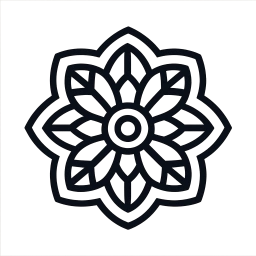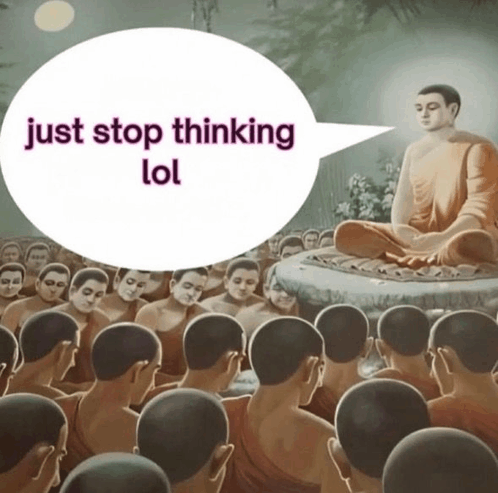Siddharta Gautama (later known as Buddha), a prince, saw rather ordinary sights: an old dude (reminder of time marching on perhaps), a sick man (a reminder of fragility perhaps), a dead man (literally “you will die, my dude”), and an ascetic, literally something he was not. Someone living differently (spoiler alert).
These 4 sights literally gave the man an existential crisis, so in the middle of a night he exited the group chat (his family), shaved his head, put on a monk’s robe and started his quest to find meaning.
So he did some travelling, did some meditation, and behold, The Four Noble truths with an Eightfold path were born.
Altogether, they form a code of ethics (mostly optional, let’s be honest), a call to mindfulness and presence (totally achievable without sitting cross-legged for 30 years), and some juicy paradoxes.
So. Let’s have a look at the core of buddhism.
The Four Noble Truths (aka Buddha Describes a “So, Life Seems to Suck” Starter Pack)
- Dukkha – Life is suffering.
(Or, more charitably: life is unsatisfactory, impermanent, full of craving and decay.) - Samudaya or Origin of Suffering – The cause of suffering is desire and attachment to impermanence.
(We want stuff, we don’t get it, we suffer. We get it, it changes or ends, we suffer. Basically: “just stop wanting, bro.”) - Nirodha or Cessation of Suffering – There is an end to suffering.
(Enlightenment, detachment, some kind of internal mic drop.) - Magga – The way to end suffering is the Eightfold Path.
(A nice Buddhist to-do list for stopping your inner whine.)
Now, notice how the fourth truth suddenly received 8 subchapters. Huh. Let’s dig in.
The Eightfold Path (aka Buddha Shows a “Self-Help Routine for Deleting Yourself”)
Divided into three categories: Wisdom, Ethics, and Mental Discipline.
I. Wisdom (Prajñā):
- Samyag-dṛṣṭi or Right View – Understand reality as it is and especially the 4 Noble truths (we’ll return to this later).
- Samyak-saṅkalpa or Right Intention – Intend to renounce, to not harm, to do good (basically, want not to want).
II. Ethical Conduct (Śīla):
- Samyag-vāc or Right Speech – Don’t lie, gossip, or talk shit (so, no offending anyone).
- Samyak-karmānta or Right Action – No killing, stealing, or sexual assault.
- Samyag-ājīva or Right Livelihood – Don’t make money doing shady stuff (bye-bye marketing jobs, I guess).
III. Mental Discipline (Samādhi):
- Samyag-vyāyāma or Right Effort – Avoid bad thoughts, nurture good ones (yes, thought-policing yourself).
- Samyak-smṛti or Right Mindfulness – Be fully aware of your body, feelings, thoughts (now you’re your own therapist and heart monitor).
- Samyak-samādhi or Right Concentration – Practice deep meditation (enter the No Thoughts, Head Empty zone).
It all makes sense. Except…
The Four Noble Truths and the Eightfold Path form a paradox of delicious recursiveness. Specifically, the Fourth Truth and the Right view.
Buddha’s Möbius Strip
The Fourth Truth tells you to follow the Eightfold Path,
and the very First Step of the Path (Right View) tells you to understand… wait for it…
The Four Noble Truths.
Let that loop cook.
To escape suffering, you must begin to walk the path.
To walk the path, you must understand the truths.
To understand the truths, you must walk the path.
It’s Buddha’s Möbius strip of spiritual logic. You don’t climb a ladder — you rotate forever on an existential hamster wheel labeled “Freedom.”
BUT.
There’s an exit clause. And it’s hidden in meta-awareness.
When you become a buddhist, you reinforce the path, the truths, you reinforce your buddhistness.
Now: Samudaya or Origin of Suffering – The cause of suffering is desire and attachment to impermanence.
You’ve grown attached to Buddhism.
To become enlightened, once you’re humble enough to let go of your ego,
this includes Buddhism itself.
There can never be an enlightened buddhist.
The moment you claim it, you’re back in the loop, back on the raft.
What raft, you might ask? There is the raft parable. Essentially, the parable suggests that the teachings of the Buddha, like a raft used to cross a river, are meant to be a means to an end, not an end in themselves.
But, this is incomplete.
Buddhism is a raft, that can never touch the other shore.
You can’t even see the other shore, until you have left the raft.
Desire is the root of suffering, but you need to desire to end desire to escape suffering. It’s like trying to punch your way out of punching.
Not just that, attachment is another root of suffering. If you call yourself a buddhist, you’re attached!
HAHAHAHAH no wonder people meditate 30 years and become frustrated. Keep calling yourself a buddhist and it becomes a part of your ego!
Expecting a specific outcome reflects desire, and is attachment.
It’s fucking brilliant to be honest. The lengths we have to go through to understand the simplest things is a cosmic joke.
Buddha’s Road, Not Yours
Now, are the Eightfold Path and the Four Noble Truths necessary?
I think not.
Sure, the Right Effort just makes sense either way.
Right Mindfulness too.
I suspect there are other routes than meditation (such as introspection).
Right Livelihood? I suspect a barman could get enlightened, why not? Because some dude who wrote down his own journey said so?
Way to gatekeep, thanks buddy.
Right Speech? I bet the barman gossips!
Right intention? Hot take time. An asshole, too, can get enlightened.
You won’t like it, but an enlightened person will definitely be able to tell “Yo momma” jokes and say EZ at the end of a moba game.
Understanding suffering is the critical one.
What makes you suffer?
Why does it make you suffer?
Do I desire to escape suffering?
And I have to end my desire of escaping it?
Interesting.
Sounds suspiciously like radical acceptance, the ancient art of shrugging and saying “it is what it is”.
A realization: you are what you are.
But what are you without all that makes you you?
No labels, no paths, no history, no values, no truths? No frameworks?
You are what you are in what you are.
And you must experience this, not just intellectualize.
In fact, the intellectualization is optional.
Possibly harmful.
If you begin to build ontologies and epistemologies, all you are doing is interior decoration for a house that was never there.
So, is Samsara even real? Or just a concept that becomes real once you think you are in it?
The emptiness of emptiness.
The gateless gate.
The cageless can make a cage made of cagelessness.
No Buddha to find
No isms under the starless sky
No sky, only this


Leave a Reply